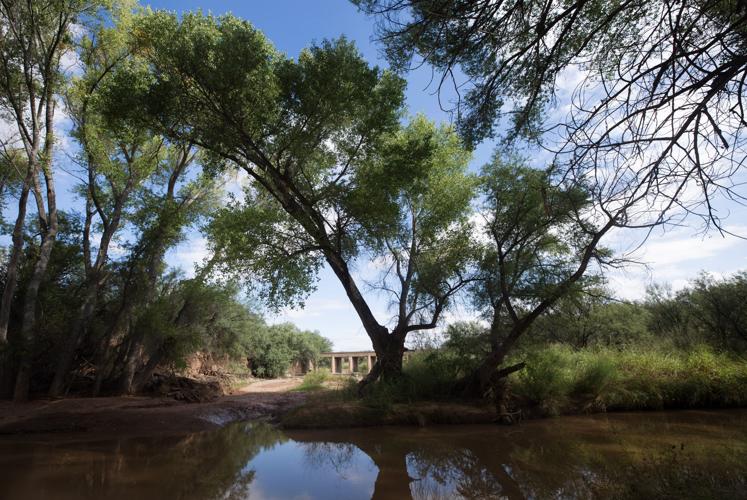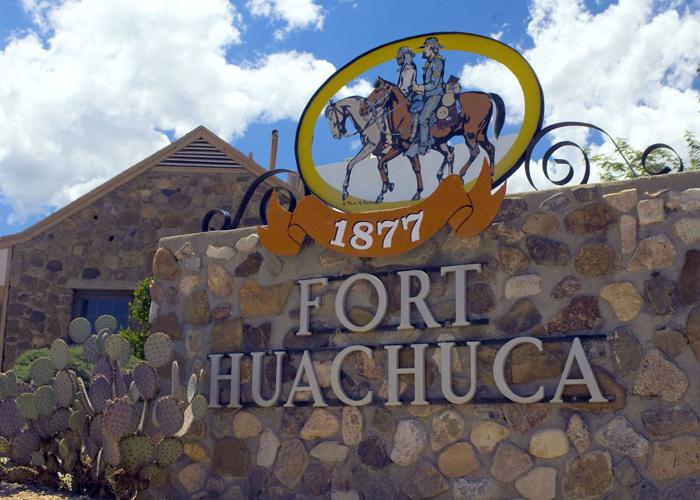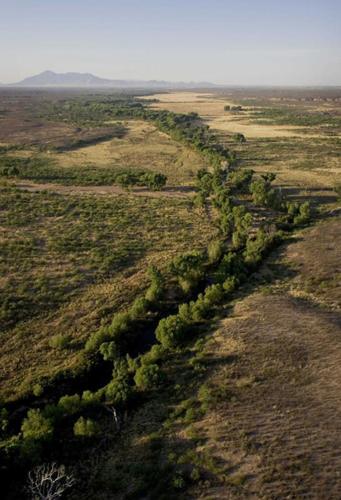Groundwater pumping done by and caused by Fort Huachuca has already harmed the San Pedro River — the Southwest’s last free-flowing desert river — and will hurt it more in the future, says an internal report done for the fort by a private consultant.
The report, written nearly a decade ago but not publicly disclosed until now, showed that pumping attributable to the U.S. Army fort has hurt the long-imperiled river since 2003. Written by the firm GeoSystems Analysis Inc. of Tucson, the report said the pumping:
- Dried up two stretches of a major San Pedro tributary, the Babocamari River, in 2003.
- Will dry up four stretches on the Babocamari and another section of the San Pedro by 2050.
- Three of those same stretches will still be dry on the Babocamari in 2105, including the point where the tributary enters the San Pedro.
- The stretches that already dried up, or will, each run 820 feet, or more than two football fields long.
The 2010 report, marked “Confidential — For Official Use Only,” was made public last week by Robin Silver, a Flagstaff environmentalist who said it was leaked to him by a source he would not name.
Silver, a board member of the Tucson-based Center for Biological Diversity, has crusaded for decades to save the San Pedro from drying caused by groundwater pumping.
The report discussed the effects of pumping on Fort Huachuca itself as well as pumping off the fort that is attributable to the Army post, which is one of Southern Arizona’s 15 largest employers.
Such pumping provides water to active military employees and civilians who work at the post and live off-base and their families, plus base contractors and military retirees and their families. This pumped water also supplies local businesses that serve fort employees’ needs.
Silver noted that a graph in the consultant’s report also showed that an existing cumulative groundwater deficit between pumping and recharge due to the fort was as high as 300,000 acre-feet back in the 2000s. That puts the fort “in the hole,” in Silver’s words, to the tune of enough water to serve 600,000 Tucson homes for a year.
Silver accused the fort of shielding the report from public scrutiny to help it obtain a crucial federal biological clearance from the U.S. Fish and Wildlife Service five years ago. That clearance enabled the fort’s operations to continue despite environmentalist concerns about its pumping’s impacts on endangered species.
The findings of Fort Huachuca’s internal consultant’s report weren’t discussed in that formal biological opinion on the fort’s impacts. The fort did not provide its report even to the wildlife service, said Silver.
The fort and the wildlife service didn’t respond directly to questions last week from the Arizona Daily Star about the 2010 report’s substance or to Silver’s allegations of a cover-up. Wildlife service officials declined to make any comment because of the potential for litigation. The fort issued a statement discussing the biological opinion in general.
In its statement, the fort said the U.S. Fish and Wildlife Service and the Army “completed a very thorough formal consultation in 2014, regarding the potential effects of Fort Huachuca’s operations.”
The opinion, signed March 31, 2014, concluded that the Army’s ongoing and planned operations aren’t likely to jeopardize the continued survival or recovery of any imperiled species or destroy existing or proposed critical habitat, whether on post or in the nearby San Pedro and Babocomari rivers, the statement said.
Silver released the report as part of a notice that the Center for Biological Diversity and two other groups filed of their intent to sue the U.S. Army and the wildlife service for approval of the favorable biological opinion for the fort in 2014.
“Groundwater pumping is killing this beautiful river while Sierra Vista, Cochise County and the state of Arizona all refuse to help reduce groundwater use by base contractors and personnel,” Silver said in a news release announcing the notice of intent to sue.
The Sierra Club’s Grand Canyon chapter and the Maricopa Audubon Society joined in filing the notice. Under federal law, such notice must be filed at least 60 days before bringing litigation against the U.S. government.
The notice and the report’s release together represent the latest in a long series of disputes between the Center for Biological Diversity and the federal government over Fort Huachuca’s impacts on the San Pedro. The center has successfully sued to overturn several other biological opinions on the fort. The 2014 opinion it is now challenging came about after it successfully challenged an earlier opinion.
The San Pedro, which is part of a federal conservation area because of its importance to birds and other wildlife, has long been seen as imperiled by groundwater pumping in neighboring Sierra Vista, at the fort and by wells in unincorporated Cochise County near the river.
Local officials, the fort, conservationists and others have taken a number of measures to try to reduce pumping over the years. But there is still a deficit between the amount of pumping done in the basin and the amount of water recharged into the aquifer naturally by rainfall and artificially by treated sewage effluent.
Silver contends the report’s findings show the fort workforce needs to be downsized to insure that the San Pedro keeps flowing.
A fort spokeswoman did not respond to a request for comment on that point.
Silver said he was told directly via email in October by a wildlife service biologist in Tucson, Jason Douglas, that “we don’t have copies of” the 2010 report and a related document.
The internal report shows that fort officials knew back in 2014 that they had been harming the river since 2003, but they never showed the report’s findings to the wildlife service, Silver said.
“I personally believe it was intentional and deceptive” on the fort’s part to do that, Silver added.
“If you go get a bank loan and don’t put some stuff on there because it makes you look bad, that’s defrauding a bank. This is defrauding the public. It doesn’t allow for a fair accounting of the impacts on public lands,” he said.
In its statement to the Star, Fort Huachuca noted that the 2014 biological opinion made reference to the 2010 consultant’s report.
But the only references to that report in the opinion were statements on the impacts on the river from all pumping in the Upper San Pedro Basin — not from pumping by the fort, Silver countered.
Scott Richardson, a wildlife service official in Tucson, said the service can’t respond to any of Silver’s allegations because they’re linked to the notice of intent to sue. The service’s policy is typically to not comment on pending litigation, he said.
Steve Spangle, a retired wildlife service official in Phoenix who signed off on the 2014 opinion, said that if the agency had had the fort’s internal report, it certainly would have considered it.
But the service could still have signed off on a favorable biological opinion, because the fort had shown that through various mitigation measures, it would save or replace as much water as it uses, Spangle said.
Those measures included retiring of groundwater pumping for irrigation and the recharge of treated effluent near the San Pedro, Spangle said.
But Silver said those mitigation measures won’t be nearly enough to overcome the 300,000-acre-foot deficit attributable to the fort that was discussed by the 2010 consultant’s report but ignored by the 2014 biological opinion.






